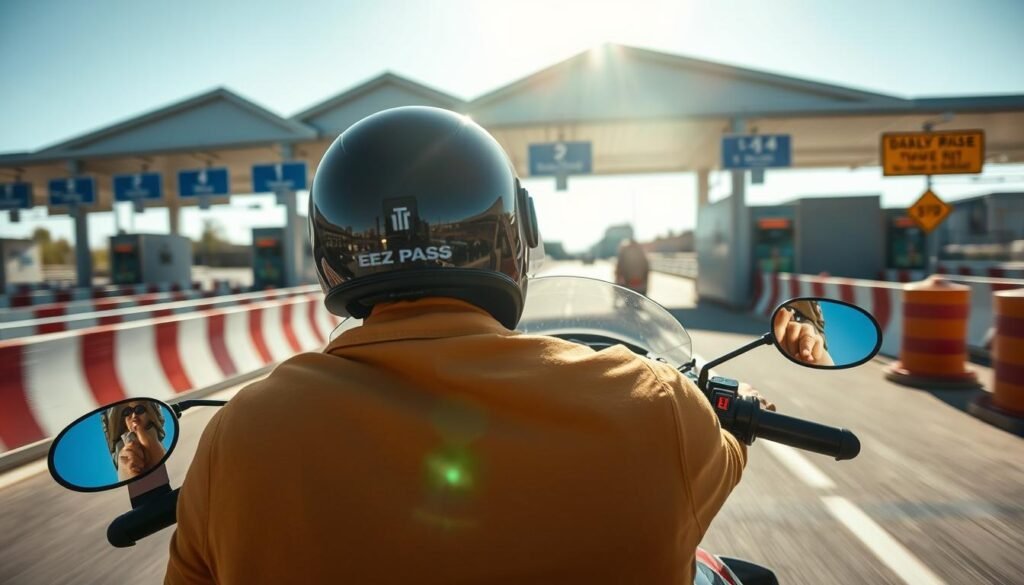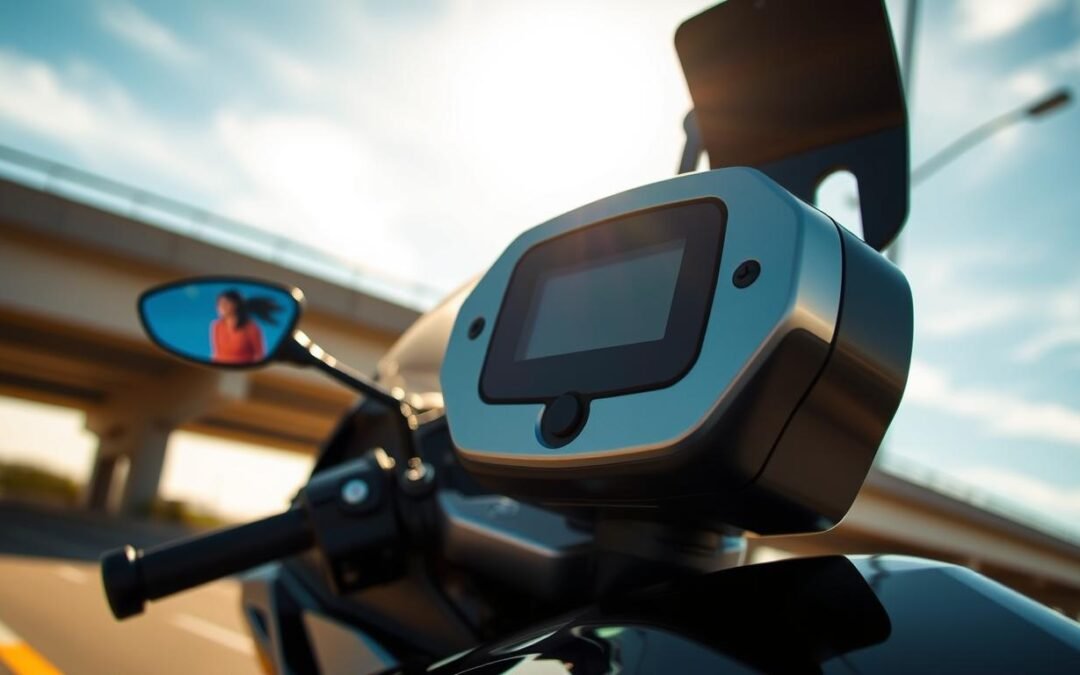Riding through toll booths doesn’t have to be a hassle. With EZ Pass, motorcycle riders in states like Pennsylvania, Maine, New York, and Illinois can skip cash lanes and avoid delays. Traditional toll payments often caused long waits and confusion, but electronic systems like EZ Pass streamline the process. Properly mounting the device ensures smooth transactions and avoids fees.
Motorcycle-specific setups matter. Unlike cars, bikes need secure, visible placements for EZ Pass transponders. This guide breaks down simple steps to make every toll encounter faster and stress-free.
Key Takeaways
- EZ Pass replaces cash at tolls, saving time and reducing errors.
- Mount the EZ Pass device where scanners can detect it easily.
- States like NY and PA offer motorcycle-specific EZ Pass instructions.
- Incorrect setups may lead to manual lane redirections or penalties.
- Planning routes with EZ Pass-enabled tolls cuts travel time significantly.
Understanding EZ Pass: How It Works for Motorcycles
EZ Pass uses radio frequency identification (RFID) to simplify motorcycle toll payments. The system’s transponder, mounted on your bike, sends a signal to toll readers. This motorcycle toll guide ensures seamless transactions across states like Pennsylvania and Maine, where compatible systems operate.
- Transponders communicate with toll booths
- Accounts auto-deduct payments from linked bank info
- No stopping needed—just pass through smoothly
| State | Toll System | Motorcycle Support |
|---|---|---|
| Pennsylvania | PA Turnpike | Full compatibility |
| Maine | MaineTurnpike | Supported with registered transponders |
Many riders in these states report smoother transitions using this tech. Proper setup matters: even sideways-mounted transponders work, but optimal placement boosts reliability. States like Pennsylvania have seen 40% faster toll processing since switching to cashless systems.
Preparing Your Motorcycle for Toll Booths
Before approaching toll booths, prepare your motorcycle and gear for a hassle-free ride. Proper preparation ensures safety and smooth EZ Pass functionality. Follow these steps to avoid delays and protect your bike.
Routine Maintenance Tips
Motorcycle maintenance tips start with checking key components. Inspect tires for tread depth and pressure. Test brakes and headlights to confirm they’re working. A clean windshield and secure grips improve control during stops. When installing your EZ Pass, use magnetic mounts or tank bag attachments to avoid scratches. Pro tip: Position the transponder where it’s visible but doesn’t interfere with airflow.
- Check tire pressure weekly
- Test brake responsiveness monthly
- Ensure windshield is securely attached
- Use non-damaging mounts for transponders
Safety Gear Essentials
Wear a DOT-certified helmet like Bell or Shoei to stay visible. Opt for abrasion-resistant jackets from brands like RIDEWIT or Dainese. Gloves with reinforced palms aid grip. Ensure gear doesn’t cover the EZ Pass unit. Bright-colored gear improves driver awareness at toll lanes.
Pro tip: Pair reflective gear with clear transponder placement for seamless transactions. Prioritize visibility and comfort to stay safe and efficient.
Navigating Toll Booths Efficiently
Mastering toll booth navigation starts with knowing the booth type ahead. Cashless lanes require a different approach than manned booths. Keep your speed steady—between 10-15 mph—as sudden stops confuse sensors. Position your EZ Pass device where it’s visible, like the handlebar or windshield mount.

- Scan signs for lane type (EZ Pass only vs. mixed traffic).
- Align your bike so the transponder faces the reader antenna.
- Avoid weaving—stick to one lane until cleared.
“I learned the hard way: cutting speed too much jams traffic behind you. Find that sweet spot—smooth and steady.” – Sarah T., 5-year rider
- Check for overhead gantries vs. manned booths
- Use rearview mirrors to spot approaching sensors
- Store receipts digitally to avoid clutter
Pro riders recommend practicing in low-traffic hours to build confidence. Always confirm the green light flashes after scanning—this confirms payment processed. Small adjustments in approach and equipment placement make all the difference in stress-free toll booth navigation.
Avoiding Common Mistakes When Using EZ Pass
Mastering cashless tolling with EZ Pass starts with knowing its pitfalls. Riders often overlook small details that cause delays or errors at toll plazas. Let’s break down how to avoid these issues and keep your journey smooth.
Misread Instructions and User Errors
Placement matters most. Many riders mount their transponder incorrectly, blocking signals or facing it away from toll readers. Cashless tolling systems rely on precise positioning—usually on the windshield or handlebars, angled toward the booth. Common mistakes include:
- Ignoring manufacturer mounting guidelines
- Blocking the device with accessories or stickers
- Forgetting to activate the transponder after installation
Handling Technical Glitches
Batteries die, signals drop, and systems glitch. If your transponder fails, don’t panic. Try these steps:
- Reboot the device by removing and reinserting the battery.
- Check for firmware updates via the official EZ Pass app.
- Call customer support if issues persist—many states offer 24/7 assistance.
Remember, even if your device malfunctions, modern cashless tolling systems often use license plate recognition as a backup. But prevention beats fixes—regular checks and setup reviews save time and fees.
Step-by-Step Guide on Using EZ Pass
Mastering EZ Pass on a motorcycle starts with precise setup and clear steps. Follow these instructions to ensure smooth toll crossings and motorcycle safety every time.
Positioning Your EZ Pass Correctly
Proper transponder placement is key. Follow these guidelines:
| Correct Placement | Rationale |
|---|---|
| Mount inside the windshield, near the rearview mirror | Ensures signal alignment with toll sensors |
| Avoid metal surfaces and defrosters | Metal and heated wires block signals |
| Align the transponder’s arrow toward the road | Matches the device’s directional requirement |
The Transaction Process Explained
- Approach the toll booth at 15-30 mph to ensure reliable signal detection.
- The transponder sends a signal to the booth, which deducts funds from your account.
- If the system doesn’t detect the transponder, cameras take a license plate photo for manual billing.
Always verify your account online to confirm charges. Proper positioning and adherence to speed limits reduce errors, enhancing both efficiency and motorcycle safety.
Tips for a Smooth Ride Through Tolls
Mastering toll navigation starts with smart preparation. Riders in New York and Chicago benefit most from knowing toll patterns and timing. Follow these steps to avoid delays:
“Electronic-payment customers are encouraged to use express lanes to avoid slowdowns,” advises the Central Florida Expressway Authority (CFX). Their network includes express lanes and 24/7 Reload Lanes for on-the-go adjustments.

Plan Your Route Ahead
- Use navigation apps like Waze or Google Maps to spot toll locations and lane types.
- Confirm toll plaza hours—some close overnight or have seasonal shifts.
- Check if your mount EZ Pass correctly placement aligns with express lanes’ sensor heights. CFX recommends 2-3 feet from the license plate for optimal detection.
Traffic and Timing Considerations
Time your trips to avoid peak hours. In Chicago, rush hours peak at 7-9 AM and 4-6 PM. If passing tolls at night:
- Approach at 10-15 mph to ensure mount EZ Pass correctly so sensors read your transponder.
- Keep 10 feet behind the vehicle ahead to prevent sensor interference.
- Have exact cash ready if using manual lanes—CFX’s 24/7 Reload Lanes let you add funds on-site.
Proper preparation turns toll stops into seamless moments on your ride.
how to go through tolls with ez pass on motorcycle
Mastering EZ Pass toll navigation on your motorcycle starts with motorcycle route planning. Begin by mounting your transponder in an open area, like the gas tank or handlebar, ensuring no metal interference blocks the signal. Always approach toll lanes at a steady speed—5-10 mph works best—keeping your bike upright and stable.
- Watch for EZ Pass signage indicating motorcycle-designated lanes. These lanes often have lower antennas to detect your transponder.
- Hold your handgrips firmly and avoid sudden movements. Let the system read your tag smoothly as you pass through.
- Check your account afterward to confirm transactions. Most systems send email alerts for easy tracking.
Many riders in states like New Jersey and Pennsylvania use this method daily. For example, on the New Jersey Turnpike, pre-planning routes with EZ Pass-enabled roads cuts wait times by up to 70%. Always carry cash or a backup tag in case of unexpected detours. Regional systems like I-Pass (Illinois) or SunPass (Florida) may require slight adjustments—check their websites for lane specifics.
Remember: Proper motorcycle route planning includes knowing toll plaza layouts. Use apps like Waze or Google Maps to spot EZ Pass lanes ahead. Stay calm and keep your eyes on the road—success is as simple as riding through smoothly.
Benefits of Using EZ Pass on Your Motorcycle
Riding with EZ Pass unlocks tangible perks for motorcycle commuters. Let’s break down how this system boosts your ride:
Cost Savings
EZ Pass cost savings add up fast. In states like New York and Pennsylvania, users save 20–30% compared to cash payments. No extra fees for late payments or missed transactions mean your wallet stays fuller.
Time Efficiency
Skipping cash lanes cuts travel time. A 2023 study showed EZ Pass users save 2–5 minutes per toll. Multiply that over weekly commutes, and hours stack up for more riding time.
Enhanced Safety Advantages
No fumbling for coins or bills means fewer distractions.“EZ Pass lets me focus on the road, not toll booths,”said a rider in New Jersey. Reduced traffic stops also lower accident risks.
These benefits turn daily commutes into smoother, safer journeys.
Conclusion
With EZ Pass, motorcycle riders gain a system that streamlines toll encounters. Proper installation and route planning ensure smooth transactions, reducing wait times and stress at toll booths. The steps outlined—from device setup to avoiding common errors—build a foundation for seamless travel.
Efficient toll processing means more time enjoying the open road and less time stuck in lines. By following the guide’s tips, riders maximize cost savings while minimizing technical hiccups. Whether navigating city bridges or rural highways, EZ Pass adapts to every journey’s needs.
Remember to pair the device with regular maintenance checks and up-to-date maps. This combination keeps trips on track and budgets in check. As you plan future routes, prioritize lanes marked for electronic tolling to maintain speed and safety.
Modern toll systems like EZ Pass are designed for convenience. By integrating these tools, riders transform routine stops into quick, hassle-free moments. Focus on the open road ahead—EZ Pass handles the rest.

